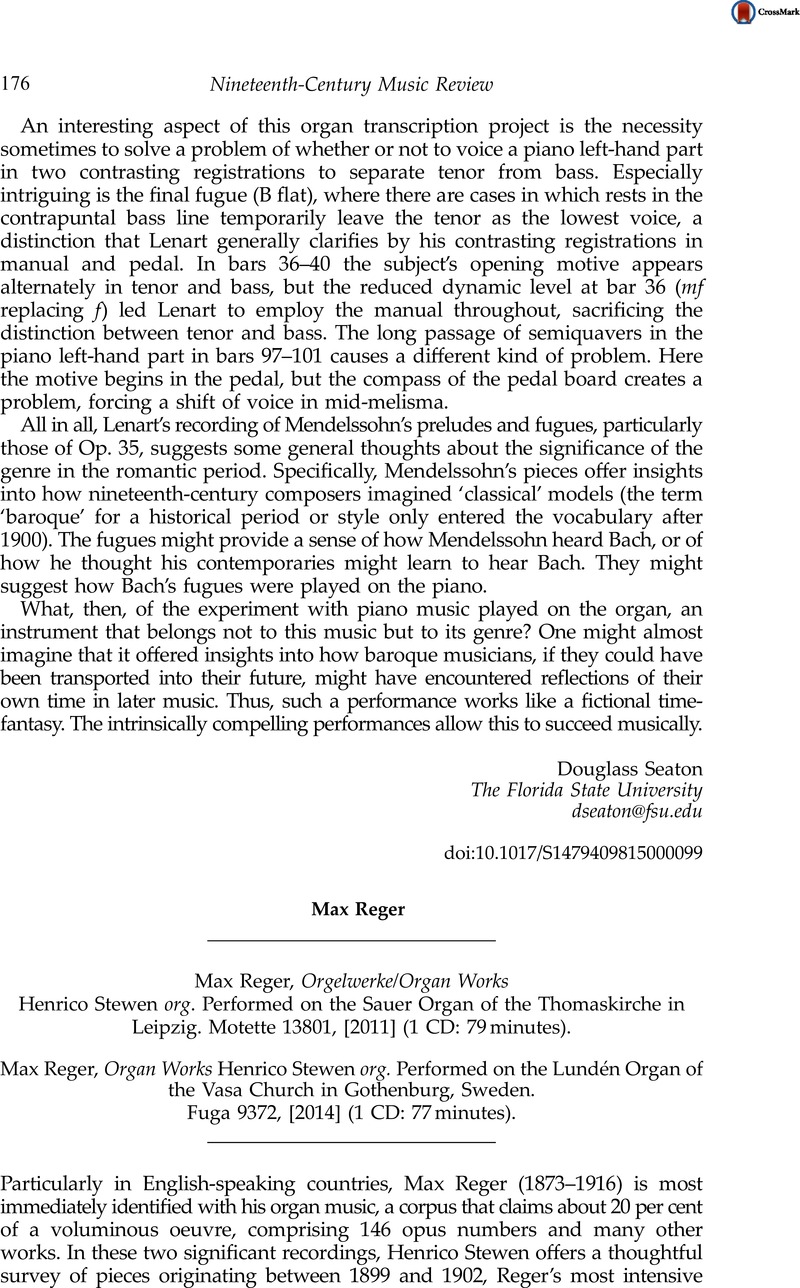No CrossRef data available.
Article contents
Max Reger - Max Reger, Orgelwerke/Organ Works Henrico Stewen org. Performed on the Sauer Organ of the Thomaskirche in Leipzig. Motette 13801, [2011] (1 CD: 79 minutes). - Max Reger, Organ Works Henrico Stewen org. Performed on the Lundén Organ of the Vasa Church in Gothenburg, Sweden. Fuga 9372, [2014] (1 CD: 77 minutes).
Published online by Cambridge University Press: 17 June 2015
Abstract

- Type
- Organ CD Reviews
- Information
- Copyright
- Copyright © Cambridge University Press 2015
References
1 Dahlhaus, Carl, ‘Structure and Expression in the Music of Scriabin’, in Schoenberg and the New Music, trans. Derrick Puffett and Alfred Clayton (Cambridge: Cambridge University Press, 1987)Google Scholar, 202. The essay appeared originally in 1972.
2 Stewen, Henrico, The Straube Code: Deciphering the Metronome Marks in Max Reger's Organ Music (Helsinki: Sibelius Academy, 2008)Google Scholar. Stewen outlines the basic thesis in both sets of liner notes as well.
3 Talsma, Willem Retze, Anleitung zur Entmechanisierung der Musik (Innsbruck: Wort und Welt, 1980)Google Scholar. See also von Gleich, Clemens, ‘Die Theorie des variablen Metronomgebrauchs’, Die Musikforschung 41/1 (1988): 46–49Google Scholar; and Auhaugen, Wolfgang, ‘Zur Theorie des variablen Metronomgebrauchs’, Die Musikforschung 42/1 (1989): 55–60Google Scholar.
4 The recordings are, respectively, MDG 3150357 (Haas), Guild 7192 (Hauk), and Naxos 8557891 (Krapp).
5 Wunderlich, Heinz, ‘Karl Straubes Vortragsbezeichnungen in der Symphonischen Phantasie und Fuge op. 57’, in Zur Interpretation der Orgelmusik Max Regers, ed. Hermann J. Busch (Kassel: Verlag Merseburger, 1988)Google Scholar, 64–71.
6 ‘… im Einverständnis mit dem Komponisten herausgegeben von Karl Straube.’ Max Reger, Drei Orgelstücke (Kyrie eleison, Gloria in excelsis, Benedictus) Opus 59 Nr. 7–9, ed. Karl Straube (C.F. Peters, 1912). The Zwölf Stücke Op. 59 appeared in 1901, the first works Reger published with the prestigious Peters house.
7 ‘According to … Talsma (1980), double-beat metronome notation concerns only relatively fast tempos for the music from pre-classicism through early romanticism. However, its use apparently lasted until the early 1900s and applies to slow tempos as well, at least in the case of Reger's early organ pieces … . It is about time that Talsma's theory is taken seriously … although its application needs to be reexamined profoundly’ (Stewen, 30).
8 Reichwald, Siegwart, ‘Mendelssohn's Tempo Indications’, in Mendelssohn in Performance, ed. Siegwart Reichwald (Bloomington: Indiana University Press, 1988)Google Scholar, 189–206; Sherman, Bernard D., ‘Metronome Marks, Timings, and Other Period Evidence Regarding Tempo in Brahms’, in Performing Brahms: Early Evidence of Performance Style, ed. Michael Musgrave and Bernard D. Sherman (Cambridge: Cambridge University Press, 2003), 99–130Google Scholar.
9 Wilske, Hermann, Max Reger: Zur Rezeption in seiner Zeit, Schriftenreihe des Max-Reger-Instituts Bonn 11 (Wiesbaden: Breitkopf & Härtel, 1995)Google Scholar, 56–8.
10 Wilske, , Max Reger, 57–58Google Scholar. This is a plausible view given Reger-the-pianist's often cited penchant for beginning fugues slowly and then speeding up, often reaching (in the ears of others) an out-of-control pace. The composer's own well-known published note to his piano Variations and Fugue on a Theme of J.S. Bach Op. 81 is relevant in this regard: ‘I ask that all the metronome marks be seen as not strictly binding; however, especially in the animated (fast) passages and particularly in the fugue, where a broad tempo will always be appropriate, the metronome marks may serve as the maximum permissible tempi with respect to “velocity,” lest the performance suffer in clarity.’ Emphases Reger's, my translation.




